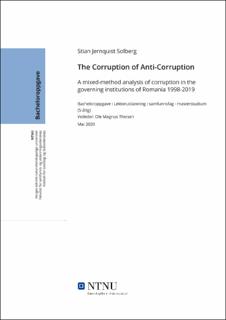| dc.contributor.advisor | Theisen, Ole Magnus | |
| dc.contributor.author | Solberg, Stian Jernquist | |
| dc.date.accessioned | 2020-07-07T16:02:45Z | |
| dc.date.available | 2020-07-07T16:02:45Z | |
| dc.date.issued | 2020 | |
| dc.identifier.uri | https://hdl.handle.net/11250/2661071 | |
| dc.description.abstract | Målet med oppgavebesvarelsen er å utforske sammenhengen mellom statsintitusjoner og korrupsjon i Romania. Som en innledende del av arbeidet presenteres et konseptuelt rammeverk av korrupsjon. Rammeverket skiller mellom (1) patrimoniske og neo-patrimoniske politiske systemer, (2) individuell korrupsjon og (3) institusjonell korrupsjon. Gjennom en kvalitativ dokumentstudie av 30 rapporter utarbeidet av Europakommisjonen identifiserer besvarelsen sentrale institusjoner og etater knyttet til anti-korrupsjonsarbeid. Utfordringene som står i veien for effektivt anti-korrupsjonsarbeid utført av institusjoner som det Nasjonale Antikorrupsjonsdirektoratet (DNA) gjør det mulig å identifisere mekanismer som muliggjør- og bidrar til korrupsjon. Sentrale funn i dokumentstudiet støttes av V-Dem indeks- og indikatormål for korrupsjon gjennom en mixed-method analyse. Besvarelsen argumenterer for at press mot etater som DNA fra utøvende statsmakt ugjør en trussel mot anti-korrupsjonsarbeidet i Romania. Videre argumenterer besvarelsen for at dette presset kan føre til institusjonell korrupering av etaten. Besvarelsen presenterer fem mekanismer som påvirker korrupsjon i Romania. Disse mekanismene er synliggjort gjonnom analyse av utfordringer DNA og andre anti-korrupsjonsetater står ovenfor i sitt arbeid. Besvarelsen argumenterer for at flere av mekanismene som hindrer anti-korrupsjonsarbeid kan spores til elementer innen lovgivende, dømmende og utøvende statsinstitusjoner. | |
| dc.description.abstract | The purpose of this dissertation is to examine the relationship between governing institutions and corruption in Romania. To engage substantially with corruption, a conceptual framework is established. The framework distinguishes between (1) patrimonial and neo-patrimonial political systems, (2) individual corruption and (3) institutional corruption. Through a qualitative document study of 30 European Commission Progress- and Technical reports, key anti-corruption institutions and agencies are identified. The challenges which impede anti-corruption efforts pursued by agencies such as the National Anticorruption Directorate (DNA) provide insight into mechanisms which contribute to- or enable corruption. Findings resulting from the document study are corroborated by V-Dem index- and indicator measurements for corruption in a mixed-method analysis. The dissertation argues that current pressure exerted on the DNA by the executive presents a threat to anti-corruption efforts in Romania – a process which could lead to the institutional corruption of the agency. Further findings result in five proposed mechanisms which have bearing on corruption. These mechanisms are derived from challenges faced by the DNA as well as other anti-corruption institutions and agencies in combatting corruption. The dissertation argues that several mechanisms made visible by obstacles preventing anti-corruption efforts can be traced to elements within the legislature, the judiciary and the executive. | |
| dc.publisher | NTNU | |
| dc.title | The Corruption of Anti-Corruption | |
| dc.type | Bachelor thesis | |
